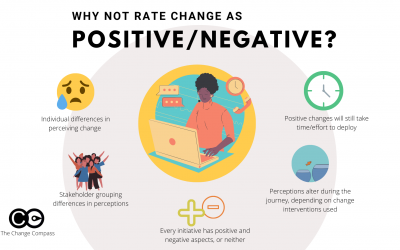Leveraging a tool such as The Change Compass is not just about data entry and interpreting data. It is about building organisational capability in managing change. This means that business stakeholders needs to be engaged, coached and supported to be able to leverage...
Latest Blogs •
How to build change analytics capability video
Positive or negative change
Change can be seen as positive or negative? In this infographic we breakdown the usefulness of labelling a change as either being positive or negative. Click here to download the infographic. To read more about this visit our article 'Is it useful to label change as...
Is it useful to label change as positive or negative?
You may have been asked to rate change into either a positive or negative change to classify initiatives and thereby use the classification to aid change implementation. After all, we all know of initiatives that nearly everyone sees as negative and other...
How to build change analytics capability
Analytics capability is emerging to be one of the most critical capabilities for companies in the digital world. How effective a company is able to use data to drive efficiency, effectiveness and overall business improvement is the ultimate competitive advantage....
Turn change data into actionable insights
Extracting Insights from Change Management Data:Change management data is the lifeblood of effective organizational transformation. Its collection and analysis provide the evidence needed to guide decisions, measure impact, and ensure that change initiatives deliver...
5 ways to graduate from change heatmaps video
Across our change management industry, it seems that producing change heatmaps and being focused singularly on one question is the norm. We all know that change is complex. Change is evolving. Change is multi-dimensional. Change is more than just answering one...
How to manage change saturation during or post COVID19
What is change saturation? Change Saturation is a concept that describes our capacity for change as limited … like a cup. We have a limited amount of capacity for change. When there is too much change going on the cup spills over and there is ‘change...
Top 7 challenges faced by change practioners in generating insights from change data
We surveyed senior change practitioners on their key challengesin using change data to generate insights, and here is what we found … Change practitioners seem to face quite a lot of challenges across the board in measuring change and demonstrating the value of...
The change data iceberg
The various types of change data available is like an iceberg. Most people only see the small part of the surface of data types such as training completion rate or change heatmap. There is a lot more beneath the surface. Download our Change Data Iceberg diagram to...
The Art of Engaging Senior Leaders with Change Data
In our fast-moving, data-centric world, the ability to capture the focus of senior leaders during data presentations is not just a valuable skill but a vital one. With attention spans growing shorter and the constant deluge of information, this challenge has become...











